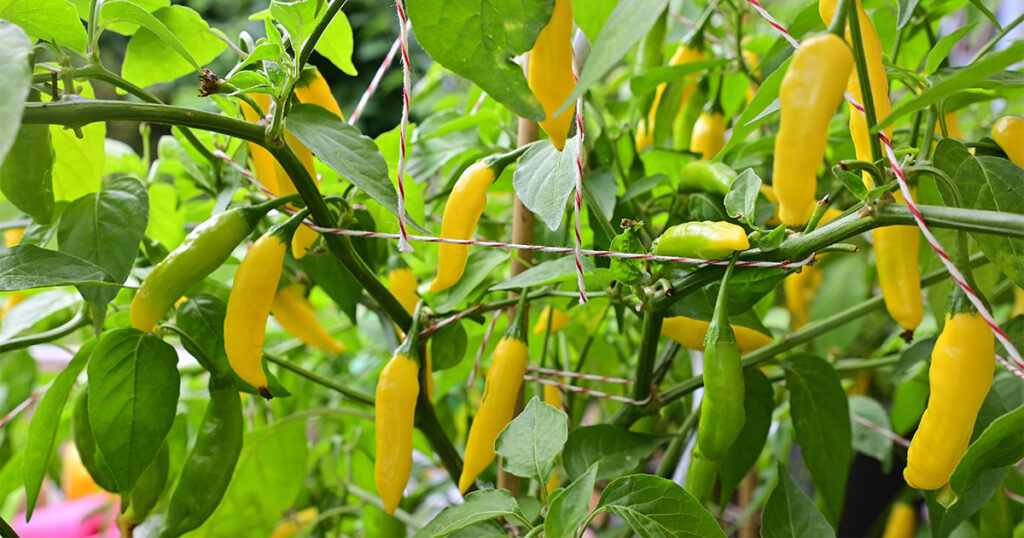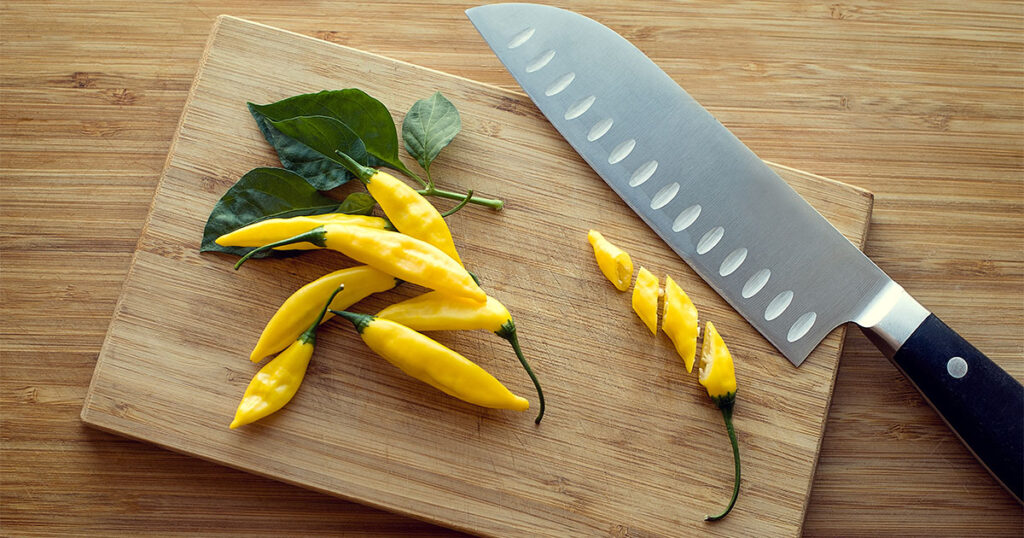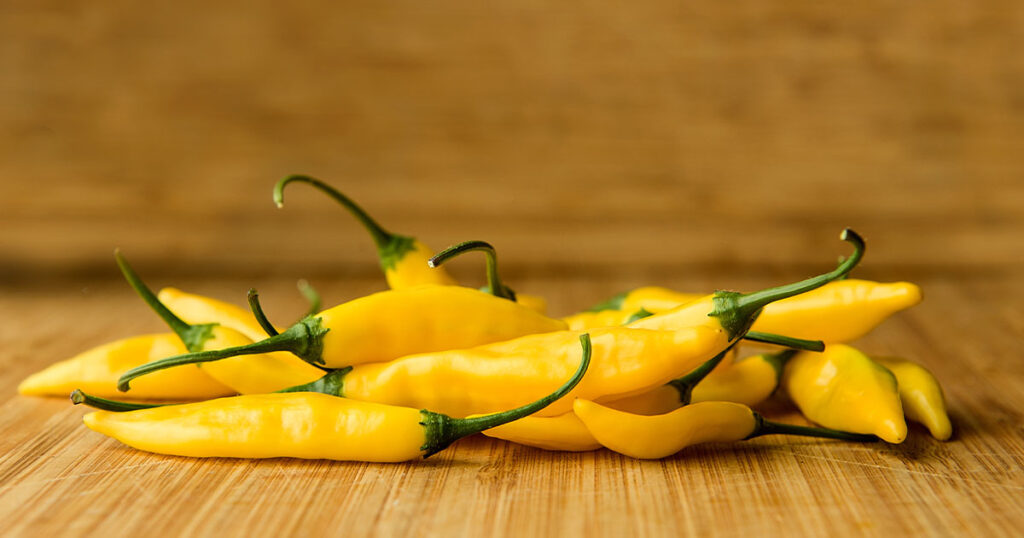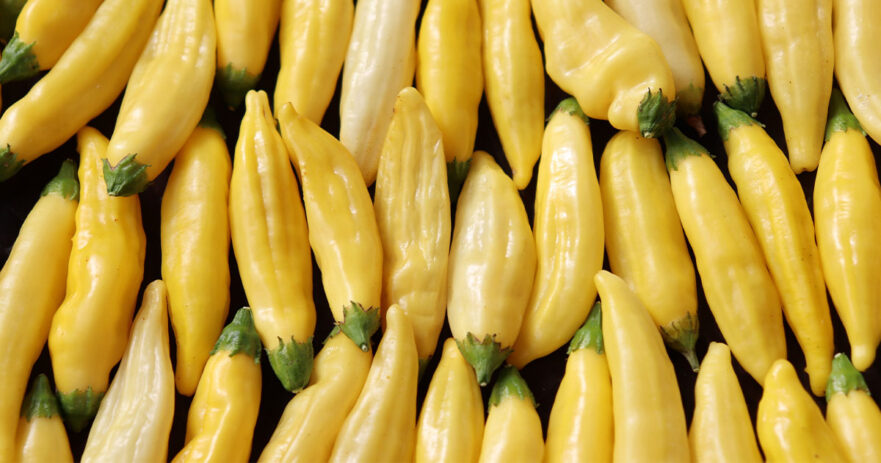In this article about lemon drop pepper:
🗺️ Origin and history | 🌶️ Uses | ✨ Appearance and taste | 🧑🌾 Growing – gardening | 👨🍳 Cooking – recipes | 🛒 Where to buy | 🫙 How to store | 👨⚕️ Health benefits | 🌶️ Alternatives and substitutes | ❓ Frequently asked questions
What is Lemon drop pepper?
The Lemon drop pepper, also known as Ají limón or Peruvian Lemon pepper, is a vibrant and spicy chili pepper renowned for its bold, citrusy flavor. Originating from Peru, this Capsicum baccatum variety is prized for its bright yellow color and medium heat level. Its unique lemony tang and aromatic qualities lend an innovative touch to various culinary creations, ranging from traditional South American dishes to modern international cuisine. Often used in sauces and salsas, the Lemon drop pepper adds a zesty kick and brightens the flavors of any dish it graces.
Are Lemon drop peppers spicy? How hot are they?
Lemon drop scoville: 15,000 to 30,000 SHU
The Lemon drop pepper is celebrated for its spicy kick, boasting a Scoville heat unit (SHU) rating of 15,000 to 30,000. This places it comfortably above the mildness of bell peppers but below the intense heat of more fiery varieties like the habanero. Compared to the common jalapeño, which ranges from 2,500 to 8,000 SHU, the Lemon drop offers a moderate yet noticeable heat. Its zesty flavor profile and heat level make it a versatile pepper in the culinary world. Despite its spiciness, the Lemon drop pepper is cherished for its ability to enrich dishes without overwhelming them, providing a perfect balance of heat and citrusy flavor. This medium heat level allows it to appeal to a wide range of palates, making it a favorite among those who appreciate a tangy spice without venturing into extreme heat territories.
🗺️ ORIGIN AND HISTORY
Where does the Lemon drop pepper come from?
The Lemon drop pepper, also known as Ají limon in its native Peru, is a bright and flavorful variety of Capsicum baccatum. Hailing from South America’s warm, sunny climes, this pepper has been a staple in Peruvian cuisine for centuries, cherished for its vibrant taste and moderate heat. The Lemon drop pepper’s history is deeply rooted in the culinary traditions of Peru, where it is used to add a zesty, citrusy flavor to a wide array of dishes. Its popularity has spread worldwide, becoming a favored ingredient among chefs and home cooks who seek to brighten their recipes with its unique taste.
🌶️ USES
What are Lemon drop peppers good for? How to use them?
Lemon drop peppers are exceptionally versatile and ideal for various culinary uses.
One of the most popular applications is in lemon drop pepper salsa, where their zesty flavor adds a bold kick to the traditional condiment, enhancing dishes with a bright, citrusy note.
Another use is creating lemon drop pepper powder; dried and ground, these peppers provide a spicy, tangy seasoning that can elevate any meal, from meats to vegetables, offering a unique twist on traditional spices.
Additionally, lemon drop pepper jam is a delightful fusion of sweet and spicy flavors, perfect for spreading on toast, glazing meats, or adding a zesty layer to cheese platters.
✨ APPEARANCE AND TASTE
What does a Lemon drop pepper look like?
The Lemon drop pepper is immediately recognizable by its bright yellow hue and elongated, tapered shape, resembling a miniature lantern. Typically measuring about 2 to 3 inches in length, these peppers have a smooth skin texture that glows with a vibrant golden color when mature. Their size and shape contribute to their ornamental appeal, making them a visually striking addition to gardens and dishes.
What does Lemon drop pepper taste like?
Lemon drop peppers are celebrated for their refreshing, citrusy flavor that distinguishes them from other chili peppers. Alongside their moderate heat, they exhibit a tangy lemon-like taste with subtle sweet undertones, offering a complex aromatic and zesty flavor profile. This unique combination of spiciness and citrus notes makes them an innovative ingredient in culinary applications, adding brightness and depth to various dishes.
🧑🌾 GROWING – GARDENING

How to grow Lemon drop peppers?
Growing Lemon drop peppers requires some care to ensure a successful harvest. These peppers thrive in warm climates and demand a sunny spot in the garden that receives at least 6-8 hours of direct sunlight daily. They prefer well-draining soil; incorporating compost or organic matter can improve soil conditions.
Starting from seeds, plant them indoors about 6-8 weeks before the last frost date. Ensure the soil is kept moist and warm to facilitate germination. Once seedlings are 3-4 inches tall and have developed their second set of true leaves, they’re ready to be transplanted outdoors. Regular watering and fertilization with a balanced fertilizer are crucial, especially during dry spells. Keep an eye out for pests and diseases and address them promptly to maintain plant health.
When to pick Lemon drop peppers?
Lemon drop peppers are typically ready to harvest when they turn a bright yellow or golden-yellow color, indicating full maturity. This stage usually occurs 75-90 days after transplanting. The peppers should be firm to the touch. A simple test is gently tugging at a pepper; if it comes off the stem easily, it’s ready for harvest. Use scissors or pruning shears to cut the pepper off, leaving a bit of the stem attached to the fruit to extend its shelf life. Handling hot peppers can irritate the skin, so wearing gloves or washing hands thoroughly after picking is recommended.
👨🍳 COOKING – RECIPES
Cooking / Recipe ideas for Lemon drop pepper
Incorporating the unique flavors of Lemon drop peppers into your culinary repertoire can transform ordinary dishes into vibrant, tantalizing creations.
One way to harness the pepper’s citrusy heat is by making a Lemon drop hot sauce, which combines the fruity and spicy notes of the peppers with ingredients like extra virgin olive oil, honey, and apple cider vinegar. This sauce is perfect for adding a kick to any dish and can be made vegan by substituting honey with agave nectar or maple syrup.
Another intriguing option is to ferment Lemon drop peppers to make a fermented lemon drop hot sauce. This method enhances the natural citrus flavors of the peppers, mellows the heat slightly, and adds a layer of complexity. Ingredients such as yellow carrots and lemon peels are added to the fermenting jar alongside the peppers and then blended with white vinegar after fermentation. This produces a zippy, tangy hot sauce that complements fish tacos, rice, and noodle bowls beautifully, showcasing the versatility of Lemon drop peppers.
Beyond hot sauces, Lemon drop peppers are also fantastic in jellies, salsas, and jams. Lemon drop pepper jelly, with its sweet and spicy balance, can be a delightful topping for cream cheese and crackers or a glaze for poultry and pork. Similarly, Lemon drop pepper salsa brings a fresh, zesty twist to traditional salsa, making it a hit with chips or as a garnish for grilled fish. Lemon drop pepper jam merges the pepper’s tangy heat with sweetness, creating a unique and irresistible spread on toast, biscuits, or even as a sauce base for savory dishes.
Each of these recipes highlights the Lemon drop pepper’s ability to add brightness and depth to a wide range of dishes, making it a cherished ingredient for cooks looking to infuse their meals with a burst of flavor and color.

🛒 WHERE TO BUY
Where can I buy Lemon drop peppers?
Finding fresh Lemon drop peppers might be challenging due to their niche popularity. They are not commonly found in regular grocery stores. Your best bet would be to check specialty food stores, online marketplaces, or local farmer’s markets specializing in exotic or heirloom varieties of fruits and vegetables.
Where can I buy Lemon drop pepper plants?
For those looking to grow Lemon drop peppers themselves, buying live plants can jumpstart your gardening project. Local nurseries, especially those specializing in hot peppers or exotic plants, might carry them. Online gardening stores are also a good place to look, as they often offer various pepper plants, including rarer types like the Lemon drop.
Where can I buy Lemon drop pepper seeds?
Seeds can be purchased from several reputable online retailers. These websites usually offer seeds in various quantities to suit different gardening needs, from small personal gardens to larger cultivation projects. They provide an opportunity to grow these unique peppers even if live plants or fresh peppers are not readily available in your area.
🫙 HOW TO STORE
How do I store Lemon drop pepper?
To store Lemon drop peppers for short-term use, place them in a plastic bag or an airtight container and keep them in the refrigerator, ideally in the crisper drawer. This method helps maintain their freshness and flavor for up to 2 weeks.
Can Lemon drop peppers be frozen?
Yes, Lemon drop peppers can be frozen for long-term storage. Wash the peppers thoroughly first. You can freeze them whole or slice them according to your future use. Place the peppers on a baking sheet in a single layer and freeze until solid to prevent them from sticking together. Once frozen, transfer the peppers to a freezer-safe bag or container. Frozen Lemon drop peppers can be used directly from the freezer in cooked dishes, providing a convenient way to enjoy their spicy, citrusy flavor year-round.
❤️🩹 HEALTH BENEFITS

Are Lemon drop peppers healthy?
Lemon drop peppers, like many chili peppers, offer a variety of health benefits, making them a nutritious addition to your diet. These vibrant yellow peppers are not only known for their citrusy flavor and moderate heat but also for their nutritional value.
Lemon drop peppers are low in calories and rich in vitamins, particularly Vitamin C, essential for supporting the immune system and promoting overall health and skin integrity. They also contain capsaicin, the compound that gives chili peppers their heat. Capsaicin has been studied for its anti-inflammatory and pain-relieving properties, offering potential health benefits such as aiding digestion, providing pain relief, and even reducing the risk of chronic diseases.
However, like all spicy foods, Lemon drop peppers should be consumed in moderation, especially by individuals who might experience gastrointestinal discomfort from capsaicin.
Incorporating Lemon drop peppers into your diet could contribute to a well-rounded intake of nutrients alongside a balanced diet to leverage their health benefits while enjoying their unique flavor.
🔄 ALTERNATIVES AND SUBSTITUTES
What’s a suitable alternative to Lemon drop pepper?
Finding a suitable alternative to Lemon drop pepper, with its citrus flavor and medium heat (15,000-30,000 SHU), can be a challenge.
However, Habanero or Scotch Bonnet peppers are viable substitutes. They share similar fruity undertones but have a significantly higher heat level, with Habaneros and Scotch Bonnets typically ranging from 100,000 to 350,000 SHU. Adjusting the quantity used can help match the desired heat and flavor profile, making them an effective alternative for those looking to replicate Lemon drop pepper’s unique characteristics in recipes.
How do you pronounce Lemon drop pepper?
The Lemon drop pepper is pronounced as LEM-on drop PEP-er.
🙋 FREQUENTLY ASKED QUESTIONS
FAQ about lemon drop peppers
How hot is the Lemon drop pepper?
The Lemon drop pepper boasts a Scoville Heat Unit (SHU) rating of 15,000 to 30,000, positioning it between the milder bell peppers and the more intense varieties like the habanero. This moderate heat level, combined with its distinctive citrusy flavor, makes it a sought-after choice for adding zest and warmth to dishes without overpowering them.
Can you eat green Lemon drop peppers?
Yes, green Lemon drop peppers can be eaten, although they are not yet fully ripe. Consuming them green may result in a slightly different flavor profile and a reduced heat level compared to their mature, yellow counterparts. As they ripen, their characteristic citrusy flavor and spiciness intensify, offering a more vibrant taste experience.
Is lemon pepper a real pepper?
Lemon pepper is not a real pepper in the botanical sense but a seasoning blend that combines granulated lemon zest with cracked black pepper. This mix combines the zesty, tangy flavor of lemon and the sharp, spicy notes of black pepper, adding a distinctive taste to various dishes. It's important to note that "pepper" in this context refers to black pepper, not chili peppers, highlighting the blend's versatility in culinary uses.
What’s the difference between Lemon drop pepper and jalapeño?
Lemon drop peppers and jalapeños differ significantly in heat and flavor. Lemon drops, with a SHU of 15,000 to 30,000, are hotter than jalapeños, typically ranging from 2,500 to 8,000 SHU. Additionally, Lemon drops offer a unique citrusy flavor absent in the earthier taste profile of jalapeños.
What’s the difference between Lemon drop pepper and habanero?
While both Lemon drop peppers and habaneros are celebrated for their heat, habaneros (100,000 to 350,000 SHU) are significantly hotter than Lemon drops (15,000 to 30,000 SHU). Flavor-wise, both peppers have fruity notes, but Lemon drops are distinguished by their unique lemony flavor, whereas habaneros have a more pronounced sweetness and intensity.

